
Pulque Octli Conejo Blanco started back in 2018 in the tiny coastal village of San Francisco,Nayarit when Jorge Luis Ugalde, one of the now founders of the company, traveled to the Mexican Pacific coast offering 100% natural pulque from Hidalgo. Like everything, this has its
challenges as pulque is a “live” product that continues to ferment and is quite difficult to stabilize complicating its transport to hotter and more humid climates. From this challenge, Pulque Octli Conejo Blanco was born — with the vision of the three founding partners to revindicate
pulque as the emblematic Mexican drink full of history, cultural significance and with nutrionally benefitial properties. This renewed vision of pulque attempts to offer a completely new experience of pulque drinking — with a modern presentation highlighting pulque’s unique flavor
and nutritional properties (high contents of vitamin C/B2, probiotic bacteria that can prevent gastrointestinal diseases) always respecting the historical and cultural significance of pulque.
About the Name
Pulque Octli Conejo Blanco incorporates many of the historical words associated with pulque. Octli is the original nahuatl (Aztec language) word for pulque. The word pulque in Spanish comes from a misrepresentation of octli poliuhqui (spoiled pulque) which is in common use as
pulque continues to ferment spoiling quite quickly.
Conejo Blanco (White Rabbit) – Pulque’s discovery is attributed to rabbits as they were often seen making holes at the base of the agave plant and sucking on the aguamiel (agave sap); mostly so, at the end of the plant’s life when the saturated sugars started to ferment. In this fashion, in Aztec mythology, rabbits became the Centzon Tōtōchtin — the 400 rabbits — children of the goddess Mayahuel, associated with fertitlity and drunkeness.

AbV: 4%
Content: 355ml
Production Details
Agave: Atrovirens
Fermentation vats: Oak
Fermentation time: 10-14 days
Serving recommendation
Shake gently before opening. Serve chilled.
Tasting Notes
Viscous consistency; sweetness with lacteous acid notes.
Pulque is predominantly consumed “as is” straight out of the container. However, it is often made into curados — blended with fruit, nuts or even legumes. Popular curados in Mexico include pineapple, pine nut, celery, mango, tomato and almond. Pulque has also made its way into Mexican cuisine in the form of salsas (salsa borracha), in birria and even a sweetener for atole and desserts.
INGREDIENTS
2 pounds of tomatillos
3 chiles serranos
1 garlic
½ onion
¾ cup of Pulque Octli Conejo Blanco
Salt to taste
INSTRUCTIONS
In a pan, brown the tomatillos, chiles
serrano, garlic and onion.
Blend all the ingredients with the pulque
and season with salt to taste
INGREDIENTS
1 ripe banana
1 bunch of pecan
1 bottle of Pulque Octli Conejo Blanco
1 bunch of oats
Cinammon to taste
INSTRUCTIONS
All all the ingredients in a blender and
blend for 2 minute
Serve in a cold glass and
season with cinammon to taste
INGREDIENTS
6 ounces of Pulque Octli Conejo Blanco
1/2 oz. of white rum
5 grams pineapple
1/2 oz. coconut cream
1/2 oz. evaporated milk (unsweetened
condensed milk)
1/2 oz. condensed milk
Ice
Cherry
INSTRUCTIONS
Add pulque, rum, pineapple, coconut
cream, evaporated/condensed milk and
ice in a blender.
Blend for a few seconds till smooth
Garnish with cherry
INGREDIENTS
2 ounces of Pulque Octli Conejo Blanco
1 oz. eggnog
1/2 oz. of vodka
1/2 oz. of simple syrup
Ice
Lime rind
INSTRUCTIONS
Add the ice, pulque, eggnog, vodka
and simple syrup in a blender.
Serve into a Tom Collins glass
Garnish with lime rind
Pulque Production
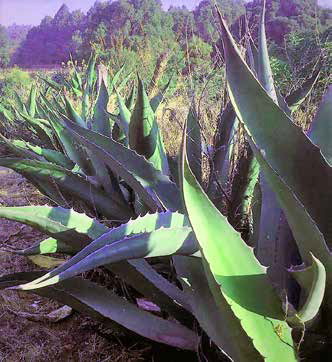
Agave Atrovirens is cultivated and grown in the highlands of central Mexico — also known as the “Altiplanicie mexicana”. This agave varietal is quite large with a large concentration of sugar in its heart. It takes seven to eight years to mature sufficiently for pulque production.
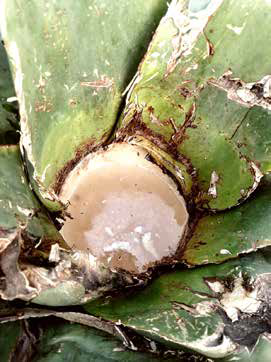
When the plant reaches maturity, a large hole is carved out of the trunk (mezontete). This causes the plant to go into shock and, to try to heal itself, it releases a sap known as aguamiel.
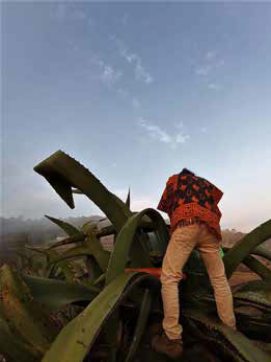
The task of extracting the aguamiel is carried out by tlachiqueros who use a hollowed-out squash gourd to suck in the aguamiel and decant it into the transport vessels to take back to the large waiting vats for fermentation. Eight to ten liters are extracted daily from one plant.

The tlachiquero will use a veriety of tools to ensure the plant keeps on producing aguamiel day after day. At the end of each extraction, they use a raspador to scrape the inside of the hole to re-injure the plant forcing it to produce an additional ten
liters.
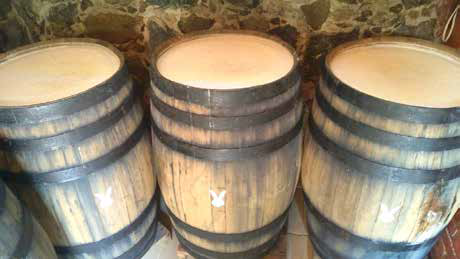
The aguamiel collected daily from the agave fields is decanted into fermentation vats. Pulque Octli ferments its pulque in Oak vats (unlike other pulqueros who use plastic or Pine)
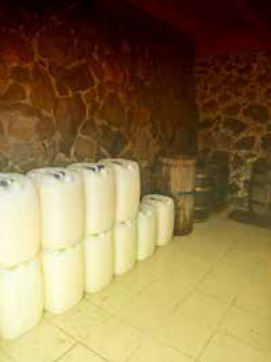
The finished pulque is stored for transportation.
Part of the production goes directly to pulquerias in the large cities (Pachuca, Mexico City) and a portion is subsequently transported to Pulque Octli’s pasteurization and packaging plant.

